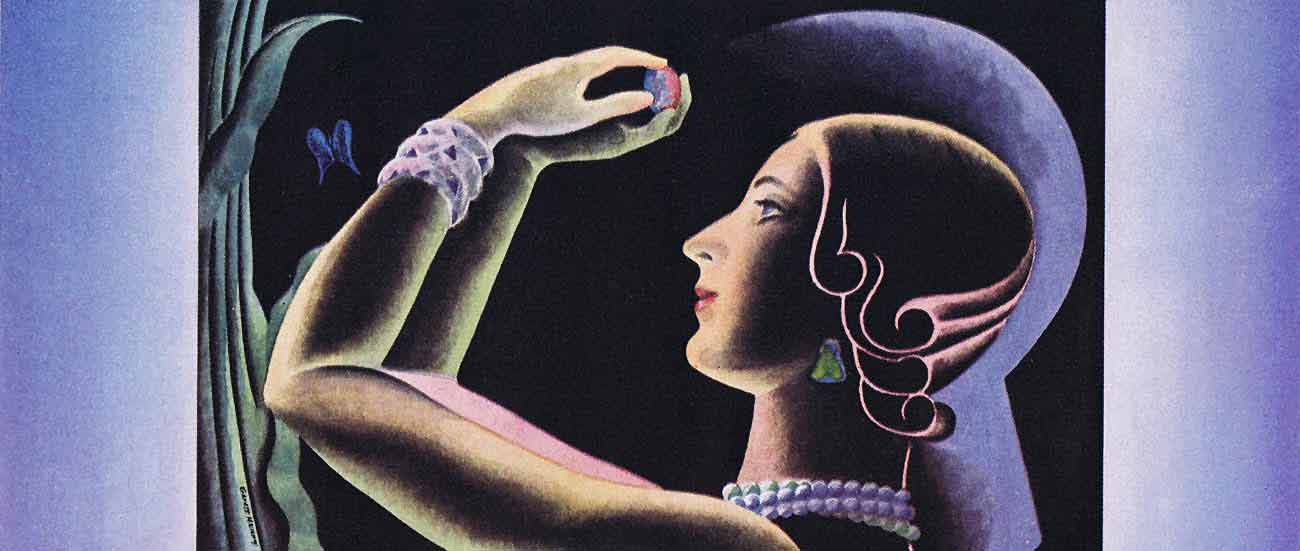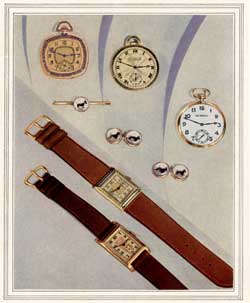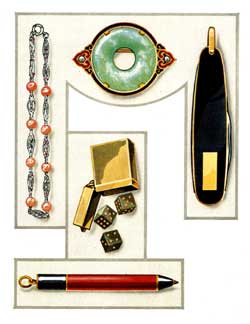The Art Deco movement was a popular design style of the 1920's that often used strong colors and geometric shapes to convey the "modern" look. It used sleek, streamlined forms to convey elegance and sophistication.

Costume Jewelry was popular during the 1920's
Costume jewelry became popular in the early 1920's when the new fashions for women were casual as well as sporty, and were not very well suited to the formal nature of precious stones. The Art Nouveau movement had already shifted the public's focus to appearance rather than cost. Following the war there was a major trend toward non-precious jewelry.
This was a period of wonderful new inventions, upbeat music, and flappers. Jewelry materials ranged from the new plastics through to rubies, gold, and platinum. Platinum was the new luxury metal used with stones like coral, jade, aquamarine, citrin, onyx and opal. Trend-setting designers were Coco Chanel and Elsa Schiaparelli.
Inspiration came from such diverse sources as Nature, China and Japan, and the Pharoahs of Egypt. Following Howard Carter's discovery of Tutankhamen's tomb and artifacts in 1922 Egyptian motifs were the rage. While many of the designers of the 1920's based their jewelry on geometric forms: circles, arcs, squares, rectangles and triangles etc. there were other designers who took their inspiration from nature.

High quality cutting and polishing of precious and semi-precious gem stones with the aid of machines took over from the traditional hand cutting and polishing which had been used for thousands of years. This meant that more facets and complicated and new cuts could be introduced to show stones in their best possible light.
The fashions of the twenties required new and different fashion accessories. The new style dresses with their low cut neck-lines and shorter sleeves provided opportunities to display jewelry around necks and wrists. Various clips and pins helped to maintain modesty by supporting underwear and fixing sashes around the waist. Beaded bags in colorful designs were draped over the shoulder or fixed to a belt and looked absolutely stunning.
Flappers were often draped with large strings of beads. There was an art to wearing jewelry as decoration especially in the upper classes. The fashion in jewelry was often set by the well-to-do who were observed and reported by others and then copied.

Once synthetic plastics became widely available it became possible to mass produce jewelry which made it more affordable. Plastic suited the new mechanical processes and design philosophies and was available in a wide variety of colors and finishes. Manufacturers sprang up along the length of the East Coast of America to produce beads, bracelets, brooches, pendants, pens and buckles that mimicked existing materials like tortoise-shell and pearl, but also explored new directions.
The advantage of plastic jewelry was in its lightness and simplicity. Bakelite (phenolic resin) which had been around since the early 1900's was light, warm, and very tough and could be used to imitate natural materials. New processes were developed in the 1920's which increased the number of colors it could be produced in.
More expensive jewelry crafted in white gold or platinum and featuring precious stones, but still using geometric shapes, was favored by the wealthy. Magnificent pieces of jewellery were sold by Tiffany and other high-class jewelers, which remain among the most popular antique jewellery to this day and are eagerly sought after by collectors.
Gruen Guild Watches and Elgin Watches are typical examples of expensive tastes in 1920's jewelry, with the top of the range models costing more than a years salary of a typical worker. For example, The 1927 Gruen Bracelet Watch for ladies, with an 18-jewel Dietrich Gruen Extra Precision movement, iridium platinum case and full length bracelet fully paved with diamonds was $1985. Other diamond set designs were priced from $3000 to $60.
